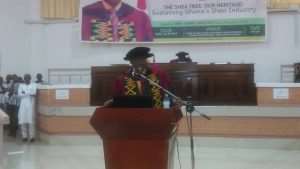
The University for Development Studies (UDS), Pro- Vice-Chancellor, Professor Seidu Alhassan has urged government to invest in the Shea nut industry.
He said the sector deserved the same attention as the cocoa industry.

“There is the need for the establishment of a national policy directive on Ghana's shea nut industry. There is the need for the government to ensure clear and adequate policy and institutional support for the industry.”
“Just like the 10-year Cashew Development Plan which was recently launched by government of Ghana, a similar one should be designed to target the shea sub-sector with a reasonable short to long-term plan characterized by an extended financial, distribution, material and technical support toward the production, sale and processing of shea nuts in the country.”

Professor Seidu Alhassan made the call at the UDS 5th Inaugural Lecture on the theme: The Shea Tree, Our Heritage; Sustaining Ghana's Shea Industry.
‘A conscious plan for the shea industry even becomes more important to support government's flagship program of One Village, One Factory Policy intending to build factories that are shea dependent. Thus, unless a clear development plan for the shea industry is put in place, this policy cannot be achieved.”
According to Professor Seidu Alhassan, the Shea industry remains the economic mainstay of Northern Ghana, hence the need to sustain it.

“Available records show that the shea industry in Ghana occupies an important place in the economic development of the country.”
“It is estimated that there are about 9.4 million Shea Trees in Ghana and these can potentially yield one hundred tonnes of shea nuts worth about US$100 million annually. It is also estimated that annual earnings from the sector currently stand at US$175 million, comprising export revenues from the raw nuts and processed butter.”
He attributed the decline in the shea tree to the lack of prompt data on the trees population, poor quality of shea products and the absence of a clear policy direction for the shea sub-sector.
“Key stakeholders in the sector do not have access to information.
The future of the country's shea industry lies in the continuous existence of shea trees. A strong sustainability of the industry highly depends on the extent to which existing trees are protected and new ones planted.”
Professor Seidu Alhassan proposed a number of interventions and innovative ideas for government’s adaptation.
“In order to maximize the export potential of shea butter in Ghana and other West African producing countries, policymakers should design policies that will improve on the education and entrepreneurial capability of shea processors. Improved market access cannot be attained unless business owners have the necessary entrepreneurial skills and education capacity.”

“The education process should include training in improved methods of packaging and marketing. Efforts should be made by civil society organisations and national and international shea networks like the Shea Network Ghana and Global Shea Alliance to sensitize shea processors to become aware of international market standards and promotion.”

Professor Seidu Alhassan earlier on June 22, 2015, at the then Tamale Sports Stadium launched a book on the Shea Tree.




 Tuesday’s downpour destroys ceiling of Circuit Court '8' in Accra
Tuesday’s downpour destroys ceiling of Circuit Court '8' in Accra
 SOEs shouldn't compromise on ethical standards, accountability – Akufo-Addo
SOEs shouldn't compromise on ethical standards, accountability – Akufo-Addo
 Father of 2-year-old boy attacked by dog appeals for financial support
Father of 2-year-old boy attacked by dog appeals for financial support
 Jubilee House National Security Operative allegedly swindles businessman over sa...
Jubilee House National Security Operative allegedly swindles businessman over sa...
 Nobody can order dumsor timetable except Energy Minister – Osafo-Maafo
Nobody can order dumsor timetable except Energy Minister – Osafo-Maafo
 Mahama wishes National Chief Imam as he clock 105 years today
Mahama wishes National Chief Imam as he clock 105 years today
 J.B.Danquah Adu’s murder trial: Case adjourned to April 29
J.B.Danquah Adu’s murder trial: Case adjourned to April 29
 High Court issues arrest warrant for former MASLOC Boss
High Court issues arrest warrant for former MASLOC Boss
 Align academic curriculum with industry needs — Stanbic Bank Ghana CEO advocates
Align academic curriculum with industry needs — Stanbic Bank Ghana CEO advocates
 Election 2024: We'll declare the results and let Ghanaians know we've won - Manh...
Election 2024: We'll declare the results and let Ghanaians know we've won - Manh...
